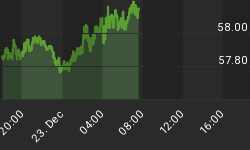Signs Of The Times:
"BHP says credit crunch will not affect metal prices."
- August 21
Hank Paulson and Ben Bernanke to Senate Banking Committee:
"Fed will use all tools available" to stem crisis.- August 21
"US [home] foreclosure filings rose 9 percent from June to July, and surged 93 percent over the same period last year."
- August 21 AP
As someone wiser than us wondered "How does an injection of administered liquidity help a company that is already insolvent or bankrupt?"
Then there is the hope that GSEs such as the discredited Fannie and Freddie are going to restore market confidence.
And then there is the quip from a financial market veteran "The sudden absence of liquidity seems to be accompanied by an equally sudden loss of veracity."
"Traders who would formerly have taken the precaution of reducing their commitments just in case a reaction should set in, now feel confident that they can ride out any storm which may develop. But more particularly, the repeated demonstrations which the market has given of its ability to 'come back' with renewed strength after a reaction has engendered a spirit of indifference to all the old time warnings. As to whether this attitude may not sometime itself become a danger-signal Wall Street is not agreed."
- New York Times, September 1, 1929
Stock Market: Our theme since April has been that bull markets typically conclude with rational exuberance. Rational in the sense that typically the concluding stage runs some 12 to 16 months against an inverted yield curve. Inversion began in February 2006, which counts out to a peak of speculation by around June.
Within this is the very critical observation that it is when the curve reverses to steepening that the most blatant speculations begin to fail.
The curve reversed in May and the salient events have been the resumption of the subprime problem and its disregard of the "containment" theory. We thought that the contagion would eventually encompass all credit spreads and that it would be a cyclical change.
This seems to be the case and the other immediate fallout with the reversal in the yield curve was the 54% crash in the price of nickel. Base metals are also likely working on a cyclical change.
The other point is that while the senior stock indexes were not enjoying the exuberance seen with the peak in 1Q 2000 the intense speculation was in financial innovation and the housing sector. The latter's record decline in the median price at some 11 consecutive months triggered the problem.
While the establishment, including the Fed, was going on about "liquidity" pushing the stock market the fall in house prices confirmed our view that as with any previous great boom today's mania needed rising prices and the credit markets would not be able to handle falling prices.
The next rational step was that the initial hit to the most reckless action in the credit markets would not be "contained" and would afflict most, if not all aspects of credit.
This has worked its way from the discovery of illiquidity in the subprime to the discovery of a serious loss of liquidity in the traditional corporate bond market. Junk took a more than 20-point price hit.
Any credit expansion will eventually become irresistible to the point where "everyone" is fully exposed to the hazard of falling prices. Then going the other way, when weakening prices reveal the loss of phoney liquidity, it eventually impacts all aspects of credit. The next hit on the schedule will be to long-dated treasuries and that will be another downer for the stock market.
The bond market will be reviewed below, but it is important to look for the next threat in this kind of market. Well, it isn't going to come from earnings, valuations, or the economy.
At the moment pundits are touting these comforts as well as the abilities of the Fed to juice the stock market with an injection of money it has borrowed or created out of thin air, as well as the next cut in administered rates.
We have argued that once the curve reverses to steepening central bank attempts to push the boom are typically denied by further yield curve steepening. Full post-bubble steepening includes short-dated market rates declining as long-dated treasuries increase.
On the initial panic the bill yield declined from 4.94% on July 12 to the exceptional low of 2.45% on August 20. With this the 30-year went from 5.23% to 4.98% on the 20th. The yield has since declined to 4.85% on the flight to safety story. This is just plain wrong. A real flight is to the liquidity of treasury bills and gold.
The next phase of steepening will have two negatives on the stock market - declining short rates and rising long rates, and it's best to keep in mind that at the peak of a credit cycle essentially the Fed has little influence on the direction of the curve.















